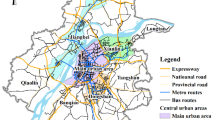Abstract
Service area research is one of the pivotal topics in Urban Geography. This article first put forward a model of urban population estimation. And on the basis we measured the size and distribution of population in downtown Shanghai, China. The population model was confirmed well by the traditional survey model. Then we extracted a 1-month actual-time data set contains geo-location by collecting in Sina Weibo data, and generated Voronoi diagram by these data which denoted the service patches. We assigned population to each patch. Second part, we proposed a shortest distance algorithm, a minimum time algorithm and an improved p-median algorithm, took advantages of these three methods to divide the service area of metro stations based on patches. Subsequently, we computed the service population in each service area. Last, we took metro line 1 and 2 as examples to research the relationship among 3 location-allocation methods in detail. The results showed that: The spatial distribution of population of the core city in Shanghai emerged a descending trend from center to periphery clearly. All indicators (including area, population, distance and time) in central city within inner ring road have changed little compared with the region between inner and outer ring road. Yet the improved p-median algorithm has a certain effect of optimization. It presented a scientific and rational travel scheme for citizens cost smallest price to select better starting metro station. The study results should contribute to theoretical and technical support for location-allocation of public service facilities.











Similar content being viewed by others
References
Applebaum, W. (1968). The analog method for estimating Potential Store Sales. In C. Kornblau (Ed.), Guide to store location research (pp. 232–243). Reading: Addison-Wesley Publishing Company.
Applebaum, W., & Green, H. L. (1974). Determining store trade areas. In R. Ferber (Ed.), Handbook of marketing research (pp. 4313–4323). New York: Mc-Graw Hill.
Brunner, J. A., & Mason, J. L. (1968). The influence of driving time upon shopping center preference. Journal of Marketing, 32(2), 57–61.
Cho, E., Myers, S. A., & Leskovec, J. (2011). Friendship and mobility: user movement in location-based social networks. Proceedings of the 17th ACM SIGKDD international conference on Knowledge discovery and data mining. New York: ACM, pp. 1082–1090.
Christaller, W. (1966). Central places in Southern Germany. Englewood Cliffs: Prentice Hall Inc.
Ghosh, A., & McLafferty, S. L. (1987). Location strategies for retail and service firms. New York: Free Press.
Hartigan, J. A. (1975). Clustering algorithms (pp. 8–10). New York: Wiley.
Indriasari, V., Mahmud, A. R., Ahmad, N., & Shariff, A. R. M. (2010). Maximal service area problem for optimal siting of emergency facilities. International Journal of Geographical Information Science, 24(2), 213–230.
Jin, C., Huang, Z., Xu, J., & Gu, Q. (2013a). Evaluation of travel convenience for residents in the Yangtze River Delta, China. Asia Pacific Journal of Tourism Research, 18(8), 865–879.
Jin, C., Xu, J., Lu, Y., & Huang, Z. (2013b). The impact of Chinese Shanghai–Nanjing high-speed rail on regional accessibility. Geografisk Tidsskrift—Danish Journal of Geography, 113(2), 133–145.
Kim, H., & Nam, J. (2013). The size of the station influence area in Seoul, Korea: based on the survey of users of seven stations. International Journal of Urban Sciences, 17(3), 331–349.
Lee, S., Yi, C., & Hong, S.-P. (2013). Urban structural hierarchy and the relationship between the ridership of the Seoul Metropolitan Subway and the land-use pattern of the station areas. Cities, 35, 69–77.
Li, X., Shi, X., He, J. Q., & Liu, X. P. (2011). Coupling simulation and optimization to solve planning problems in a fast developing area. Annals of the Association of American Geographers, 101(5), 1032–1048.
Liang, S. (2009). Research on the urban influence domains in China. International Journal of Geographical Information Science, 23(12), 1527–1539.
Liu, X., Ou, J., Li, X., & Ai, B. (2013). Combining system dynamics and hybrid particle swarm optimization for land use allocation. Ecological Modelling, 257, 11–24.
Liu, Y., Sui, Z., Kang, C., & Gao, Y. (2014). Uncovering patterns of inter-urban trip and spatial interaction from social media check-in data. PLoS ONE, 9(1), 1–11.
Mestre, A. M., Oliveira, M. D., & Barbosa-Póvoa, A. P. (2015). Location–allocation approaches for hospital network planning under uncertainty. European Journal of Operational Research, 240(3), 791–806.
Ortigosa, J., & Menendez, M. (2014). The relationship between urban structure and traffic demand. Cities, 36, 18–27.
Rapid transit (2014-12-18) http://en.wikipedia.org/wiki/Rapid_transit.
Tsekeris, T., & Geroliminis, N. (2013). City size, network structure and traffic congestion. Journal of Urban Economics, 76, 1–14.
Urban rail transit in China (2014-12-18) http://en.wikipedia.org/wiki/Urban_rail_transit_in_China.
Vidyarthi, N., & Jayaswal, S. (2014). Efficient solution of a class of location–allocation problems with stochastic demand and congestion. Computers & Operations Research, 48, 20–30.
Wu, L., Zhi, Y., Sui, Z., & Liu, Y. (2014). Intra-urban human mobility and activity transition: Evidence from social media check-in data. PLoS ONE, 9(5), 1–13.
Yu, B., Shu, S., Liu, H., Song, W., Wu, J., Wang, L., & Chen, Z. (2014). Object-based spatial cluster analysis of urban landscape pattern using nighttime light satellite images: a case study of China. International Journal of Geographical Information Science, 28(11), 1–28.
Zeev, S., Meidad, K., & Avinoam, M. (2014). A multi-spatial scale approach to urban sustainability: An illustration of the domestic and global hinterlands of the city of Beer-Sheva. Land Use Policy, 41, 498–505.
Zhang, L., & Lu, Y. (2007). Regional accessibility of land traffic network in the Yangtze River Delta. Journal of Geographical Sciences, 3, 351–364.
Author information
Authors and Affiliations
Corresponding author
About this article
Cite this article
Wang, Z., Shi, P. Analyses of Metro Station Service Area in Shanghai Downtown Based on Traffic Networks. J Indian Soc Remote Sens 45, 337–352 (2017). https://doi.org/10.1007/s12524-016-0595-0
Received:
Accepted:
Published:
Issue Date:
DOI: https://doi.org/10.1007/s12524-016-0595-0




